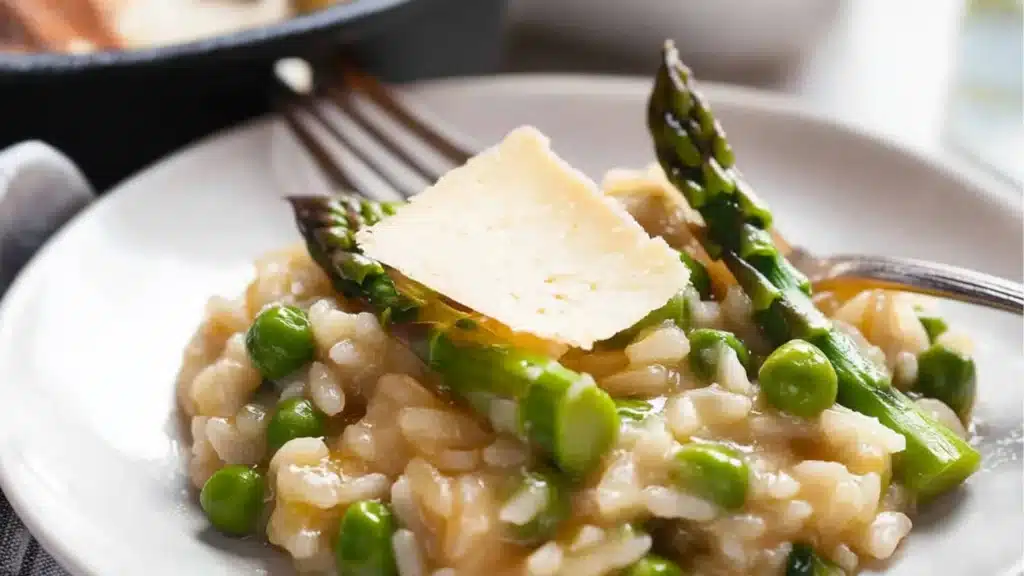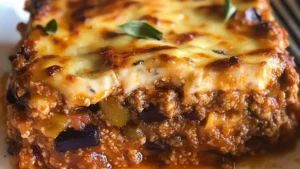Introduction: A Bright and Comforting Easy Risotto Recipe with Asparagus and Peas
Looking for a springtime dinner that’s vibrant, creamy, and full of flavor? This Easy Risotto Recipe with Asparagus and Peas is the answer. Whether you’re planning a cozy dinner at home or hosting a seasonal get-together, this elegant vegan risotto brings out the best of fresh produce in a truly satisfying dish. With just a few pantry staples and seasonal vegetables, you can create a restaurant-quality risotto in your own kitchen — no chef training required.
Perfect as a main course or one of your elegant starters for dinner, this asparagus risotto is light yet filling, and ideal for both weeknight meals and special occasions. If you’re looking for risotto recipes easy enough for beginners but impressive enough for guests, this one’s for you.
Table of Contents
Why You’ll Love This Spring Risotto
There’s something magical about spring produce — sweet peas, tender asparagus, and a touch of lemon — all coming together in one delicious pot. This spring risotto recipe:
- Uses simple, plant-based ingredients
- Is naturally gluten-free and dairy-free
- Comes together in under 40 minutes
- Is rich in fiber and plant protein
- Makes an elegant meatless main or a light starter
With a touch of lemon and nutritional yeast (or vegan cheese, if you prefer), this lemon asparagus risotto feels fresh, light, and comforting — all at once.
Ingredients for Asparagus and Peas Risotto
Here’s what you’ll need to make this flavorful and healthy risotto with asparagus and peas. These ingredients serve about 4 people:
Produce & Pantry
- 1 tablespoon extra virgin olive oil
- 1 yellow onion, finely chopped
- 2 cloves garlic, minced
- 1 bunch (300g) fresh asparagus, ends trimmed and chopped into 1-inch pieces
- 1 cup (130g) frozen peas
- Zest of 1 lemon
- Juice of 1 lemon (about 2 tablespoons)
Grains & Liquids
- 1 cup (200g) Arborio rice
- 4 cups (1 liter) vegetable broth (warm)
- ½ cup (120ml) water (optional, for consistency)
Seasonings & Flavor
- Salt and black pepper, to taste
- 2 tablespoons nutritional yeast (or vegan parmesan)
Kitchen Equipment You’ll Need
To make this recipe smooth and stress-free, gather the following tools:
- Large sauté pan or wide pot
- Wooden spoon or silicone spatula
- Ladle (for gradually adding broth)
- Small saucepan (to warm the broth)
- Citrus zester or fine grater
- Measuring cups and spoons
How to Make This Easy Risotto Recipe with Asparagus and Peas
Step 1: Warm the Broth
Begin by warming the vegetable broth in a saucepan over low heat. This helps the risotto cook evenly when the broth is added.
Step 2: Sauté the Base
In a large pan, heat the olive oil over medium heat. Add the chopped onion and sauté for about 3–4 minutes, until soft and translucent. Add the garlic and stir for another minute until fragrant.
Step 3: Toast the Rice
Add the Arborio rice to the pan and stir well to coat the grains in the oil. Toast for 1–2 minutes until the rice is slightly translucent around the edges.
Step 4: Add Broth Gradually
Start adding the warm vegetable broth, one ladle at a time, stirring continuously. Allow each addition to be absorbed before adding more. This process takes about 20–25 minutes.
Step 5: Cook the Vegetables
After 10 minutes of adding broth, stir in the chopped asparagus. Continue cooking with broth until the asparagus is tender, about another 10 minutes. In the last 3–4 minutes, stir in the peas.
Step 6: Add Flavor
Once the rice is creamy and cooked al dente, stir in the lemon zest, lemon juice, nutritional yeast, salt, and pepper. Adjust seasoning to taste.
Step 7: Serve
Remove from heat and let rest for 2 minutes. Serve warm, garnished with extra lemon zest or fresh herbs if desired.
Tips for Making the Perfect Vegan Asparagus Risotto
Use warm broth: Cold broth can shock the rice and slow down the cooking.
Stir consistently: Stirring helps release the starch from the Arborio rice, which creates that signature creaminess.
Don’t rush the process: Risotto is all about slow, steady cooking. Give the rice time to absorb the liquid.
Taste before serving: Adjust salt, pepper, and lemon juice based on your personal taste.
Use seasonal produce: If available, use farmer’s market asparagus and sweet peas for optimal flavor.
Delicious Variations of Risotto with Asparagus
This recipe is a great base — here are some delicious twists you can try:
Add mushrooms: Sautéed mushrooms bring an earthy depth to this spring risotto.
Use green beans or zucchini: Both pair beautifully with peas and lemon.
Make it creamy: Stir in a spoonful of plant-based cream or vegan butter at the end for a silkier texture.
Add protein: Toss in some roasted chickpeas or grilled tofu for a protein-packed version.
What to Serve with Asparagus and Peas Risotto
This dish is filling on its own, but pairs beautifully with:
- Simple green salad with lemon vinaigrette
- Roasted carrots or beets
- Grilled vegetables like zucchini, eggplant, or bell peppers
- Crusty whole grain bread
For drinks, pair with sparkling water infused with lemon or cucumber for a refreshing complement.
How to Store and Reheat Leftovers
Got leftovers? Great news — risotto stores well with a few simple steps:
Refrigerate: Store in an airtight container for up to 3 days.
Freeze: Though best fresh, it can be frozen for up to 1 month.
Reheat: Add a splash of vegetable broth or water and reheat on the stove over medium heat, stirring gently until warmed through.
Avoid microwaving without liquid, as this can dry out the risotto and make it gummy.
Serving and Presentation Ideas for Easy Risotto
Want to wow your guests or just treat yourself? Try these ideas:
- Top with lemon zest and fresh mint or basil
- Serve in shallow bowls for a restaurant-style look
- Garnish with microgreens or thin asparagus tips
- Use a ring mold to shape the risotto neatly on the plate
Presentation matters — and a few small touches go a long way.
FAQs About Spring Risotto Recipes
Can I make this risotto ahead of time?
Yes, you can prep the vegetables ahead, but for best texture, cook the risotto fresh and reheat gently if needed.
Can I use brown rice instead of Arborio?
Brown rice takes longer to cook and won’t create the same creamy consistency. Arborio or other short-grain rice types are best.
Is this risotto gluten-free?
Yes! All the ingredients used are naturally gluten-free.
What if I don’t have nutritional yeast?
You can skip it or replace it with any vegan cheese you prefer. It adds a savory, cheesy flavor.
Final Thoughts + Call to Action
This Easy Risotto Recipe with Asparagus and Peas proves that elegant, flavorful meals don’t have to be complicated. With simple ingredients, fresh produce, and a little patience, you can create a satisfying dish perfect for any night of the week. It’s a celebration of spring in every bite — creamy, zesty, and deliciously wholesome.
PrintIrresistibly & Fresh: Easy Risotto Recipe with Asparagus and Peas
- Total Time: 40
Description
Looking for a springtime dinner that’s vibrant, creamy, and full of flavor? This Easy Risotto Recipe with Asparagus and Peas is the answer.
Ingredients
Produce & Pantry
- 1 tablespoon extra virgin olive oil
- 1 yellow onion, finely chopped
- 2 cloves garlic, minced
- 1 bunch (300g) fresh asparagus, ends trimmed and chopped into 1-inch pieces
- 1 cup (130g) frozen peas
- Zest of 1 lemon
- Juice of 1 lemon (about 2 tablespoons)
Grains & Liquids
- 1 cup (200g) Arborio rice
- 4 cups (1 liter) vegetable broth (warm)
- ½ cup (120ml) water (optional, for consistency)
Seasonings & Flavor
- Salt and black pepper, to taste
- 2 tablespoons nutritional yeast (or vegan parmesan)
Instructions
Step 1: Warm the Broth
Begin by warming the vegetable broth in a saucepan over low heat. This helps the risotto cook evenly when the broth is added.
Step 2: Sauté the Base
In a large pan, heat the olive oil over medium heat. Add the chopped onion and sauté for about 3–4 minutes, until soft and translucent. Add the garlic and stir for another minute until fragrant.
Step 3: Toast the Rice
Add the Arborio rice to the pan and stir well to coat the grains in the oil. Toast for 1–2 minutes until the rice is slightly translucent around the edges.
Step 4: Add Broth Gradually
Start adding the warm vegetable broth, one ladle at a time, stirring continuously. Allow each addition to be absorbed before adding more. This process takes about 20–25 minutes.
Step 5: Cook the Vegetables
After 10 minutes of adding broth, stir in the chopped asparagus. Continue cooking with broth until the asparagus is tender, about another 10 minutes. In the last 3–4 minutes, stir in the peas.
Step 6: Add Flavor
Once the rice is creamy and cooked al dente, stir in the lemon zest, lemon juice, nutritional yeast, salt, and pepper. Adjust seasoning to taste.
Step 7: Serve
Remove from heat and let rest for 2 minutes. Serve warm, garnished with extra lemon zest or fresh herbs if desired.
Notes
Use warm broth: Cold broth can shock the rice and slow down the cooking.
Stir consistently: Stirring helps release the starch from the Arborio rice, which creates that signature creaminess.
Don’t rush the process: Risotto is all about slow, steady cooking. Give the rice time to absorb the liquid.
- Prep Time: 10
- Cook Time: 30
- Category: Dinner
- Cuisine: American
Nutrition
- Serving Size: 4
- Calories: 290
- Fat: 5g
- Carbohydrates: 42g
- Fiber: 10g
- Protein: 6g
Keywords: Easy Risotto Recipe with Asparagus and Peas








